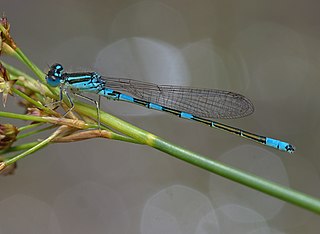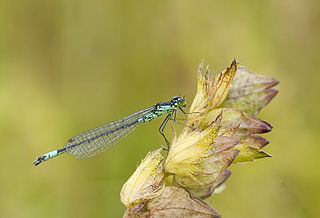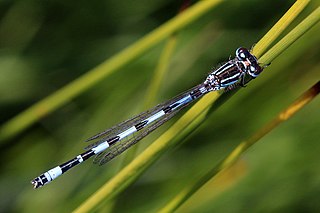
The dainty damselfly, also known as the dainty bluet, is a blue damselfly of the family Coenagrionidae. This is a scarce species found mainly in southern Europe, northern Africa, southwest Asia, and Central America. C. scitulum are Odonata predators that can reach a length of 30–33 mm at maturity and have hind-wing lengths of 15–20 mm. The males and females do exhibit differing features through their colouration making them easily distinguishable. As shown in the photo to the left, segment eight is blue in colour followed by black markings on segment nine, whereas the females are mostly black near the rear with smaller blue markings. Although they are relatively simple to sex, they are easily confused with the common blue damselfly.

The Norfolk damselfly or dark bluet is a species of blue damselfly of the family Coenagrionidae native to Eurasia.

The Italian newt is a species of salamander in the family Salamandridae found only in Italy. The species can be found in temperate forests, temperate shrubland, Mediterranean-type shrubby vegetation, freshwater lakes, intermittent freshwater lakes, freshwater marshes, intermittent freshwater marshes, arable land, pastureland, rural gardens, water storage areas, ponds, and canals and ditches. It is threatened by habitat loss, natural land conversion and invasive species. It was formerly known as Triturus italicus, but was relocated to the genus Lissotriton after Triturus was split.
Grauer's swamp warbler is a species of Old World warbler in the family Locustellidae. It is found in Burundi, Democratic Republic of the Congo, Rwanda, and Uganda. Its natural habitats are freshwater lakes and freshwater marshes. It is threatened by habitat loss.
The long-toed tree frog is a species of frog in the family Arthroleptidae found in South Africa and possibly Lesotho. Its natural habitats are temperate grassland, swamps, freshwater marshes, and intermittent freshwater marshes.
Ptychadena cooperi is a species of frog in the family Ptychadenidae. It is endemic to Ethiopia.
Ptychadena erlangeri is a species of frog in the family Ptychadenidae. It is endemic to Ethiopia.
Ptychadena gansi is a species of frog in the family Ptychadenidae. It is endemic to Somalia.
Ptychadena neumanni is a species of frog in the family Ptychadenidae. It is endemic to Ethiopia.

The long-legged wood frog, also known as Caucasus frog, Brusa frog, or Uludağ frog, is a species of frog in the family Ranidae found in Armenia, Azerbaijan, Georgia, Iran, Russia, Turkey, and Turkmenistan.

Chirixalus doriae, commonly known as Doria's Asian treefrog, Doria's bush frog, Doria's bush frog, and Doria's tree frog, is a species of frog in the family Rhacophoridae. It is found in southeastern Asia, from extreme northeastern India and adjacent Bangladesh to Myanmar, Thailand, Cambodia, Laos, Vietnam, and southern China.
The Cyprus whip snake is a species of snake in the family Colubridae. It is endemic to Cyprus.

The Congo clawless otter, also known as the Cameroon clawless otter, is a species in the family Mustelidae. It was formerly recognised as a subspecies of the African clawless otter.
Coenagrion australocaspicum is a species of damselfly in the family Coenagrionidae. It is found in Azerbaijan and Iran. Its natural habitats are rivers, swamps, and freshwater marshes. It is threatened by habitat loss.

Coenagrion is a genus of damselflies in the family Coenagrionidae, commonly called the Eurasian Bluets. Species of Coenagrion are generally medium-sized, brightly coloured damselflies.

Coenagrion mercuriale, the southern damselfly, is a species of damselfly in the family Coenagrionidae. It is found in Algeria, Austria, Belgium, France, Germany, Italy, Liechtenstein, Luxembourg, Morocco, the Netherlands, Portugal, Romania, Slovakia, Slovenia, Spain, Switzerland, Tunisia, and the United Kingdom. Its natural habitats are rivers and freshwater springs. It is threatened by habitat loss.
Coenagrion syriacum is a species of damselfly in the family Coenagrionidae. It is found in Israel, Lebanon, Syria, and Turkey. Its natural habitats are swamps, freshwater marshes, ponds, and canals and ditches. It is threatened by habitat loss.

Coenagrion hastulatum, the northern damselfly or spearhead bluet, is a damselfly in the family Coenagrionidae.
The Cretan bluet is a damselfly in the family Coenagrionidae. It used to be a subspecies of Coenagrion ponticum

Coenagrion lyelli is a species of damselfly in the family Coenagrionidae, commonly known as a swamp bluet. It is a medium-sized damselfly, the male is bright blue with black markings. It is found in south-eastern Australia, where it inhabits streams, pools and lakes.










